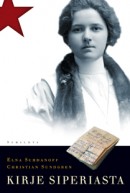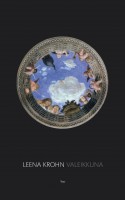Archive for June, 2009
Worlds apart
18 June 2009 | Extracts, Non-fiction

Helsinki boys by the sea: in Martti Jämsä’s Polaroid lads play on the beach; in I.K. Inha’s photograph (Hietalahden satama, ‘Hietalahti harbour’), taken a century earlier, barefoot urchins meet up on the quayside
A hundred years ago the photographer I.K. Inha (1865–1930) was asked to illustrate a tourist guide to Helsinki. He took some 200 photographs, of which some 60 were included in the book, which was published by WSOY in 1910. In his new book of photographs, OPS! Helsinki Polaroid¹, Martti Jämsä (born 1959), wanders the same streets a century on, taking snapshots with his Polaroid camera. More…
Just reading
18 June 2009 | Letter from the Editors
 The Books from Finland website has been live for two months, and we’re gradually settling in to our new mode of being. To say we were growing accustomed to our new environment, though, would be misleading. Since our last editorial, the Editor-in-Chief, the London Editor, the Web Editor and the Designer have actually spent physical time in the same room (yea, to cement the feeling of non-virtuality, they have even eaten pizza together). It would be fair to say that our reaction, jointly and severally, to publishing on line, could best be summarised as ‘Yay! This is great!’
The Books from Finland website has been live for two months, and we’re gradually settling in to our new mode of being. To say we were growing accustomed to our new environment, though, would be misleading. Since our last editorial, the Editor-in-Chief, the London Editor, the Web Editor and the Designer have actually spent physical time in the same room (yea, to cement the feeling of non-virtuality, they have even eaten pizza together). It would be fair to say that our reaction, jointly and severally, to publishing on line, could best be summarised as ‘Yay! This is great!’
Elna Schdanoff & Christian Sundgren: Kirje Siperiasta [A letter from Siberia]
17 June 2009 | Mini reviews, Reviews
 Kirje Siperiasta [A letter from Siberia]
Kirje Siperiasta [A letter from Siberia]
Finnish translation by Paula Autio
Helsinki: Schildts, 2008. 233 p., ill.
ISBN 978-951-50-1783-3
€ 29, hardback
Swedish original: Brevet från Sibirien
Esbo: Schildts, 1997. 233 p., ill.
ISBN 951-50-0865-4
€ 29, hardback
Kirje Siperiasta is based on letters and memoirs covering a period of more than 80 years by Elna Schdanoff (Russian spelling Zhdanova, 1885–1977). Born in St Petersburg, Elna belonged to a Finland-Swedish family of industrial entrepreneurs in Russia. Her father was director of a Belgian mining and steel company, and after the revolution of 1917, her Russian husband Vadya Zhdanov became the first engineer in the Soviet steel industry. In the whirlwinds of the Revolution the Zhdanovs decided to remain in the Soviet Union. Vadya Zhdanov was executed as a spy during the Stalinist purges of 1938; Elna was sentenced to tens years of forced labour and deportation. According to the book’s editor, Zhdanova’s nephew Christian Sundgren, his aunt’s memoirs were not published in Finland when she wrote them because of the self-censorship of the Finnish press. In addition to the account of her imprisonment, the book generates interest with descriptions of Russian industry before and after the revolution. In the 1950s Zhdanova’s brother finally managed to obtain permission for his sister to travel to Finland where she remained for the rest of her life.
Sealspotting
14 June 2009 | Reviews

Zzzzzzz! In the grey seal kindergarten babies take a nap after dinner. – Photo: Seppo Keränen
Taskinen, Juha
Paluu Saimaalle
[Return to Lake Saimaa]
Helsinki: WSOY, 2009. 204 p., ill.
ISBN 978-951-0-33745-5
€ 38.90, hardback
Keränen, Seppo & Lappalainen, Markku
Hylkeet [The seals]
Helsinki: Maahenki, 2009. 151 p., ill.
ISBN 978-952-56-5266-6
€ 45, hardback
Sälar
Helsingfors: Söderströms, 2009.
151 p., ill.
Swedish translation: Annika Luther
ISBN 978-951-52-2603-7
€ 45, hardback
The private life of the species of seal that lives only in Lake Saimaa has been carefully investigated lately. Almost everything about this highly endangered species has been revealed, thanks to technological devices such as transmitters that can be glued to their backs…
STOP! WARNING: as I realise that not everybody wants to know what pinnipeds do in their spare time, I suggest you quit reading now, if you aren’t interested in the lives and fates of an obscure group of about 260 mammals that live in a lake in the remote west of Finland.
Leena Krohn: Valeikkuna [False window]
12 June 2009 | Mini reviews, Reviews
 Valeikkuna
Valeikkuna
[False window]
Helsinki: Teos, 2009. 155 p.
ISBN 978-951-851-183-3
€ 21, hardback
The themes of the fiction of Leena Krohn (born 1947) have always included the distinction between life and art, the influence of the media and technology, and the dialogue between truth, illusion and falsehood. In Valeikkuna, her 28th book, the protagonist is a former student of philosophy who has installed a flotation tank in his home, where he spends most of his time, receiving customers to whom he gives advice. The philosopher ‘s teenage daughter lives in the mostly virtual but safe ‘Fake Fake Land’; their home town is ruled by the Dividers League, who use violence to establish their control. The impossibility of defining reality runs as a prominent theme throughout the novel. As is often the case in her novels, Krohn concentrates on the philosophical attitudes of her characters rather than on psychological depth; Valeikkuna is a wise and critical novel, although not perhaps among her best work. Krohn’s books have been translated into 15 languages; her novel Pereat Mundus (1998) is to be issued in English later this year by the San Francisco publisher Omnidawn.
Netta Böök & Juhani Seppovaara: Kirkosta savusaunaan [From churches to smoke saunas]
4 June 2009 | Mini reviews, Reviews
 Kirkosta savusaunaan. Puusta rakennettu Suomi
Kirkosta savusaunaan. Puusta rakennettu Suomi
[From churches to smoke saunas. A Finland built of wood]
Helsinki: Otava, 2008. 175 p., ill.
ISBN 978-951-1-20337-7
€ 33, hardback
Photographer Juhani Seppovaara and architectural journalist Netta Böök have collected examples of timber construction: timber was traditionally used to build churches, cottages, villas, farmhouses, parsonages, saunas, manor houses and entire residential neighbourhoods. The authors even include dance pavilions – thousands of them were built around the country after the Second World War. As early as the end of the 18th century, doctors were recommending timber houses as healthy places to live in. However, wars and fires have destroyed many of Finland’s wooden buildings. The book also presents stories of those who lived in them and built them. The 1960s and 1970s in particular saw the demolition of valuable timber-constructed neighbourhoods, which were pulled down in order to make way for structures of a more modern kind. Today timber is once more an inspiration for builders and developers.
Marginal notes
4 June 2009 | Essays, Non-fiction

Fast food for thought? Culture meets business. – Illustration: Joonas Väänänen
Extracts from a collection of writings, Ulkona (‘Outside’, Siltala, 2008)
Literature – and ‘serious’ writing in particular, the kinds of texts we publish in Books from Finland – is often seen as lost, irrelevant, pushed out to the edge of mainstream popular culture. But, argues Hannu Raittila, the margin is actually the area of greatest freedom. Everything worthwhile happens there – and business would do well to imitate art, rather than the other way round
It is easy to see culture as a marginal part of society, if viewed from an economic perspective. It is easy to see literature, for its part, as a marginal phenomenon even when compared with other areas of culture – pop music, for example. More…
